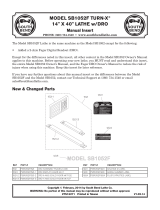
Table of Contents
INTRODUCTION ............................................... 3
Machine Description ...................................... 3
Contact Info.................................................... 3
Manual Accuracy ........................................... 3
Identification ................................................... 4
Controls & Components ................................. 5
Two-Speed Motor Switch .................................... 5
Headstock ........................................................... 5
Control Panel ...................................................... 6
Carriage .............................................................. 6
Tailstock .............................................................. 7
End Gears ........................................................... 7
Safety Foot Brake ............................................... 7
Machine Data Sheet ...................................... 8
SECTION 1: SAFETY ..................................... 11
Safety Instructions for Machinery ................ 11
Additional Safety for Metal Lathes ............... 13
Additional Chuck Safety ............................... 14
SECTION 2: POWER SUPPLY ...................... 15
Availability ......................................................... 15
Full-Load Current Rating ..................................15
Circuit Requirements for 220V .......................... 15
Grounding Instructions ...................................... 16
Extension Cords ................................................ 16
Correcting Phase Polarity Wiring ................. 17
SECTION 3: SETUP ....................................... 18
Preparation .................................................. 18
Unpacking .................................................... 18
Needed for Setup ......................................... 18
Inventory ...................................................... 19
Cleanup ........................................................ 20
Site Considerations ...................................... 21
Lifting & Moving ........................................... 22
Leveling & Mounting .................................... 23
Leveling ............................................................. 23
Bolting to Concrete Floors ................................ 24
Assembly ..................................................... 24
Lubricating Lathe ......................................... 24
Adding Coolant ............................................ 25
Power Connection........................................ 25
Test Run ...................................................... 26
Spindle Break-In .......................................... 29
Recommended Adjustments ........................ 30
SECTION 4: OPERATIONS ........................... 31
Operation Overview ..................................... 31
Chuck & Faceplate Mounting....................... 32
Installation & Removal Devices ................... 32
Chuck Installation......................................... 33
Registration Marks ............................................ 34
Chuck Removal............................................ 34
Scroll Chuck Clamping ................................ 35
Chuck Jaw Reversal .................................... 35
4-Jaw Chuck ................................................ 36
Faceplate ..................................................... 37
Tailstock ....................................................... 38
Positioning Tailstock ......................................... 38
Using Quill ......................................................... 38
Installing Tooling ............................................... 38
Removing Tooling ............................................. 39
Offsetting Tailstock ........................................... 39
Aligning Tailstock to Spindle Centerline ........... 40
Centers ........................................................ 42
Dead Centers .................................................... 42
Live Centers ...................................................... 42
Mounting Dead Center in Spindle ..................... 42
Removing Center from Spindle ......................... 43
Mounting Center in Tailstock ............................ 43
Removing Center from Tailstock ......................43
Mounting Workpiece Between Centers ............44
Steady Rest ................................................. 45
Follow Rest .................................................. 46
Carriage & Slide Locks ................................ 46
Compound Rest ........................................... 47
Four-Way Tool Post ..................................... 47
Installing Tool .................................................... 47
Aligning Cutting Tool with Spindle Centerline ... 48
Adjustable Feed Stop .................................. 49
Micrometer Stop........................................... 49
Manual Feed ................................................ 50
Carriage Handwheel ......................................... 50
Cross Slide Handwheel ....................................50
Compound Rest Handwheel .............................50
Spindle Speed.............................................. 50
Determining Spindle Speed .............................. 50
Setting Spindle Speed ...................................... 51
Configuration Examples .................................... 51
Power Feed.................................................. 52
Power Feed Controls ........................................ 53
Setting Power Feed Rate .................................. 54
End Gears .................................................... 55



























